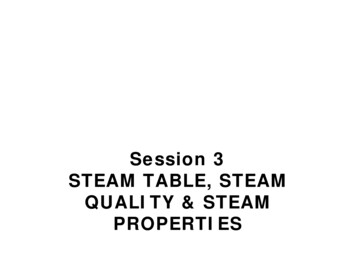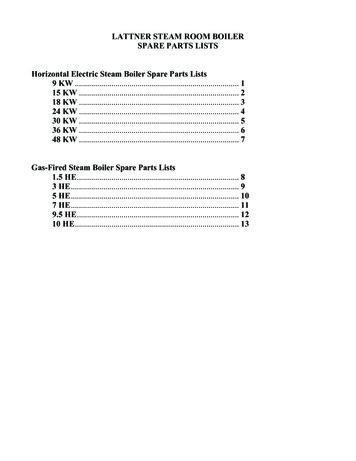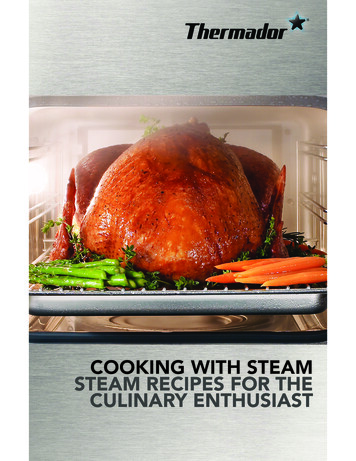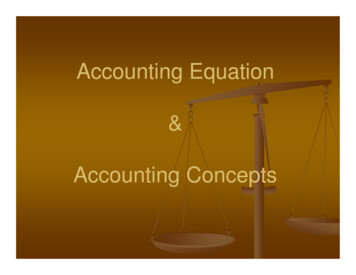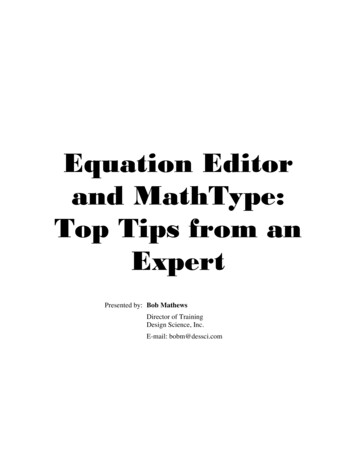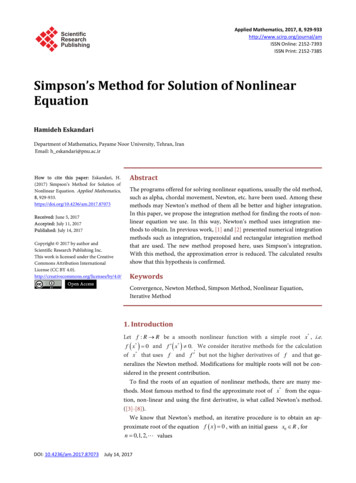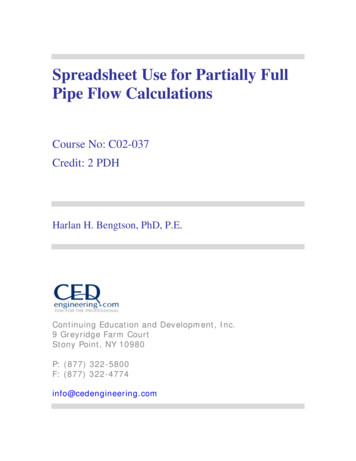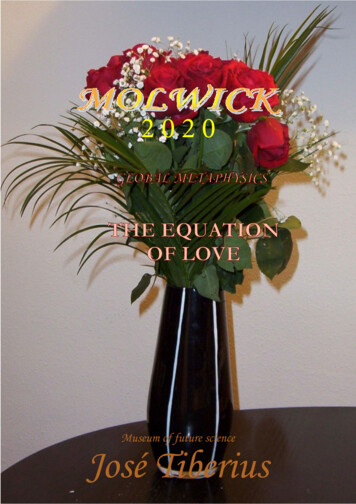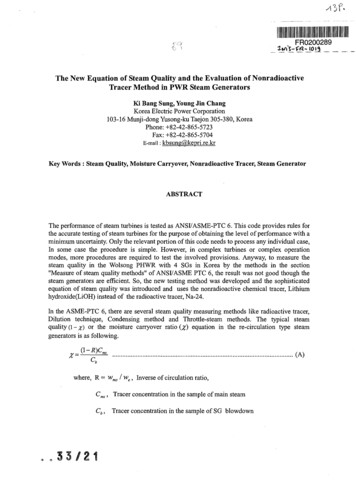
Transcription
FR0200289The New Equation of Steam Quality and the Evaluation of NonradioactiveTracer Method in PWR Steam GeneratorsKi Bang Sung, Young Jin ChangKorea Electric Power Corporation103-16 Munji-dong Yusong-ku Taejon 305-380, KoreaPhone: 82-42-865-5723Fax: 82-42-865-5704E-mail: kbsung@kepri.re.krKey Words : Steam Quality, Moisture Carryover, Nonradioactive Tracer, Steam GeneratorABSTRACTThe performance of steam turbines is tested as ANSI/ASME-PTC 6. This code provides rules forthe accurate testing of steam turbines for the purpose of obtaining the level of performance with aminimum uncertainty. Only the relevant portion of this code needs to process any individual case,In some case the procedure is simple. However, in complex turbines or complex operationmodes, more procedures are required to test the involved provisions. Anyway, to measure thesteam quality in the Wolsong PHWR with 4 SGs in Korea by the methods in the section"Measure of steam quality methods" of ANSI/ASME PTC 6, the result was not good though thesteam generators are efficient. So, the new testing method was developed and the sophisticatedequation of steam quality was introduced and uses the nonradioactive chemical tracer, Lithiumhydroxide(LiOH) instead of the radioactive tracer, Na-24.In the ASME-PTC 6, there are several steam quality measuring methods like radioactive tracer,Dilution technique, Condensing method and Throttle-steam methods. The typical steamquality (1 - x) o r the moisture carryover ratio (x) equation in the re-circulation type steamgenerators is as following.(A)where, R wms I we, Inverse of circulation ratio,Cms,Tracer concentration in the sample of main steamCb,Tracer concentration in the sample of SG blowdown
O 0 By the way, we derived a general steam quality equation as followingZT y(R' L) (R' L M(\-L)) U bWfwi- (B) (R' L) (L M(\-L) R'L) C where, R' wr I wms, Recirculation ratio L,M are SG's geometric factorsin case of the steady state, wmswould be replaced withwjwThe steam quality is 99.59% with the equation (A) in the specification limit value of 99.75%. Butthe new calculation result with the equation (B) is 99.98%.1. INTRODUCTIONGenerally, the steam supply system in Nuclear Power Plants consists in 2, 3 or 4 steamgenerators and one turbine. The steam generator is tested in the initial test step or in serviceinspection to verify the performance of heat balance and to check the electric output efficiency.The test procedures are well documented in ANSI/ASME PTC 6-series. In PWR or PHWR, thesteam generators are producing saturated steam by the moisture separator systems which areinstalled inside the SG. The moisture separators are blocking the carryover of droplet by lowerthan 0.25% steam quality because the droplets are the main causes of erosion of the turbineblades. So, quality is a very important test item and an acceptance criteria in the saturated steamturbine cycles in case of the construction NPP or the replacement.The entire performance of steam turbines are carried out by the code of ANSI/ ASME PTC 61996. The methods of determining steam quality is described in section 4.19. The following isstated the methods briefly to enhance the situations.2. MEASUREMENT OF STEAM QUALITY IN ANSI/ASME PTC 6The following methods are used to determine the steam quality of any steam turbines.(1) Radioactive-tracer technique (throttle steam and extraction steam).(2) Heater-drain-flow measurement (extraction steam only) and heat balance.(3) Calorimeter for direct determination of quality (throttle-steam only).2.1 Radioactive-Tracer TechniqueRadioactive tracers have been used for determining steam quality of throttle and extractionsteam of steam turbines operating predominately within the moisture region with nuclear-steamsupply. Although excellent results have been obtained, the techniques of the method had not beensufficiently developed, at the time PTC 19.11-1970 was published, to include them in that
Supplement. Therefore, a complete description of the tracer technique is included in thefollowing paragraphs.Selection of one of these methods for determining steam quality must be based upon theconditions peculiar to a particular steam-supply system, since each method has limitations whichgovern its use.Steam sampling, with respect to the type of probe, its location and method of withdrawing thesample, shall be performed in accordance with the ASTM "Method of Sampling Steam." D-1066.Inherent limitations in the probe-sample technique make it extremely difficult to obtain arepresentative streamline sample. (Also see PTC 19.11-1970.) The tracer technique has theadvantage that it does not require a representative sample of the water steam mixture. Only asample of the water phase is required.2.2 Dilution Technique.The dilution technique is the most accurate for determining either the water-phase or themoisture fraction of a two-phase vapor-water flow. The dilution technique is based on themeasurement of a tracer concentration in water sample and is well suited because it does not relyon geometric or hydraulic quantities. Dilution can be accomplished in either of two ways,applicable to determining both throttle and extraction enthalpy.2.3 Condensing Method.An appropriate tracer, dissolved in the water-phase of wet steam at a concentration Cw, will bediluted by condensation of vapor. After the steams is totally condensed, the tracer concentrationin the condensate will be c .The concentrations are related by the balanceCww Ccwc(2-1)where:w amount of water in steamwc amount of condensate from wet steamWith the tracer concentrations known from test measurements before and after condensation,steam-wetness (moisture) fraction( x ) is represented by the ratio:Ce/Cw(2-2)2.3.1 Throttle-Steam Quality.Throttle-steam quality can be calculated from the quality and pressure of the steam leaving thesteam generator and throttle-steam pressure, using a constant-enthalpy process since radiationlosses from the connecting steam piping are generally negligible. The moisture in the steamleaving the steam generator is the result of water-carry-over. Thus, a tracer present in the SGwater will also be found in the steam leaving the SG.
ooooThe condensing method may also be used to determine wet-extraction steam enthalpy. Thismethod is particularly attractive if a suitable tracer is already present in the steam path. However,error analysis shows that accurate results can only be obtained on heaters without cascadingdrains.With this method extraction enthalpy is evaluated from an energy balance and a tracer balancearound the heaters. For the tracer balance the concentration of the tracer in all flows to and fromthe shell side of each heater are needed. Sampling the heater drains for concentrationmeasurement of the tracer is fairly easy, as this is only single-phase flow. Sampling water out ofthe extraction line requires the same precautions as in the case of the injection method.2.3.2 Constant-Rate Injection Method.A water-soluble tracer of concentration c w is injected at a constant ratewinto the vapor-waterflow where moisture is to be measured. The concentration cw is measured in the water phasedownstream of the injection point after adequate mixing has taken place. For this condition thefollowing material can be written :jJj(2-3)Orwhere :w mass-flow rate of water in vapor-water mixtureCo initial concentration in the water-phase at the sampling point, beforeinjection starts, due to natural amounts of tracer (background concentration)3. Example of the Moisture Calculation with ANSI/ASME PTC 6To measure the steam quality of Wolsong PHWR with 4 SGs in 1999 by the methods describedin the section "measurement of steam quality" with equation (3-1), the results are no good asshown in table 1. The main reason is sampling error because the steam sample probes are nogood. Generally, the wet steam flows along piping wall. The principal disadvantage of themoisture sampling tubes is that their accuracy is directly affected by the extent to which thesteam sample represents the average condition of the steam flowing in the pipe. Although amoisture sampling tube which is designed so that the average velocity through the eight(8)sampling holes is approximately equal to the average steam velocity in the pipe. In large pipes,there is evidence that the moisture in the steam tends to collect along the pipe wall thus escapingisokinetic sampling. So, the entire steam quality is derived after the steam was condensing. Butthe equation of(3-l) hasn't the condensate term. Anyway, the moisture qualities of Wolsong areover the specification, 0.25%
oooe(3-1)where, R wmlwe, Inverse of circulation ratioTable 3.1 Moisture quality(%) in steam at Wolsong unit 4, calculated with equation (3-1)"\SGSG#2SG#4AverageDateSG#1SG#3Rx. p o w e i 0.1710.403'99.6. 20.7400.34690%0.2930.1750.6950.377'99.6. 20.3090.3660.2120.416'99.6. 295%0.7770.455100%0.2710.2320.6320.397'99.6. 84. New Equation of Steam Quality in Steam Generator with PreheaterThe equation of steam quality is derived from the mass balance of water and tracer. Accuratewater flow and tracer concentrations are also necessary. For the typical steam generators withpreheater illustrated in Figure 2.4.1 Moisture CarryoverFrom the definition of moisture carryover, the moisture carryover equation is obtained as followsw!22M!Z (4-1)wsteams moistureUnder steady-state of steam turbine systems water-steam flow, the entry feedwater flow is equalto the main steam flow with moistures.WJw Wms Wsteam moisture(4-2)hi downcomer regions, the total flow of downward is the sum of recirculating water and thefeedwater to enter in upper feeding.wdc R'wfiv Lwfiv {R' L)wfiv(4-3)where, R' is recirculating ratioL is feeding ratio of upper region.hi blowdown regions, the water flow balance is as follows,w W R'wJiv Lwfiv (l-L)wfiv (R1 l)wfi and from the tracer flow balance,CwWmoisture CmsWms .CJwWJw(4-4)
ooooandfrom equation (4-1) and (4-5), and the concentration of tracer in main steam sample andfeedwater sample is equal. cm C i under the steady state conditions)Cymssiwmoisturems(-,msft/vsteam moisturesteams-moisturewSJfw,.s\J IV/w4.2. In Downcomer Regionfafter mixing the downcomer flow and feedwater flow)If the water steam interface sampling is impossible, the equation (4-6) should be expressed withthe tracer concentration in downcomer. The downcomer water is mixing with the downward flowand the partially entered feedwater flow. By the same method, the moisture quality equation isexpressed as tracer concentration of blowdown from the mass balance flow and tracer.In the downcomer region, the mass balance of tracer is expressed as follows.w.Cj RwKCYdcdcfw Lw*C, (R L)C w,v/fwfw\/(4-7)w'rfwV '/ }andfinally, we get one equation from (4-6) and (4-8)m Dd c j wi?1fiv(R' L)Cdc-LCfwIf there is no feedwater flow in downcomer regions(L 0), the equation (4-8) is simply expressedas following.(fl'4.3 In Blowdown RegionR'CdcCdc
If the sampling is possible only in the blowdown flow, the equation (4-9) should be expressedwith the tracer concentration in blowdown. The water is mixing with entire feedwater anddowncomer flow in blowdown region.In the blowdown region, the mass balance of tracer is expressed as follows.from the water flow balance,wb R'wfiv Lwfiv (l-L)wfiv (R' l)wfiv(4-10)and from the tracer mass balance, the downcomer tracer concentration is gotSo,C4- .(4-U)from (4-9) and (4-11), We can get an equation of moisture quality.RyC,R'2CCfw)LC(A-\X\/R'If there is no downcomer feedwater flow is none(L 0), then the above equation is expressed asfollowing.13)Let us prove the ANSI/ASME PTC 6 equation from the equation (4-13)If the tracer concentration in feedwater is negligible, then c 0, andRC,,(R' l)Cb(R"-l)Cfiv (l/R-\)CJWR"Cb(\IR)Cb
oooo(\ — —&-(ANSI/ASME PTC 6 EQUATION)where, R" is circulation ratio and R is inverse of circulation ratio (R" 1/R)4.4 In case of Partially Mixed flow in Downcomer regionGenerally, the blowdown flow water and feedwater are not completely mixed by the flow barrier.In that case, the same method is available. If the mixing ratio is M, the tracer of concentration indowncomer and blowdown is expressed as following.r(R' L M(l-L))Cb -So, the final equation is derived as following.General Equation of Moisture Quality in Steam Generators is,(4-16)(R' L)(R' L M(\ - L))Cb - (R' L)(L M{\-L) i4.5 Multi Loop Steam generators General Equation of Moisture QualityIn PWR, there are loops with two or three team gernerators. Especially, PHWR have four steamgeneraors. In that case, the total steam generator system's performance is got by the belowequation that considers each steam generator's tracer concentration and steam flow capacityfactorsXr i *(R' L)(R' L M{\ -L)) c M-(R' LXL M{\ - and each steam generators' performance are get by the below equation that is considered eachsteam gernerator's capacity factor4.6 SAMPLE Equation of three(3) loops type steam generator (Westinghouse type)Westinghouse model's steam generator has downcomer region sample taps. In that case,
OQOOrand the downcomer sample is taken before mixing with the auxiliary feedwater flow, so, L 0X(R 0)Cdc-0xCfivCdcand for all steam generatorsXr SoZ And for steam generator # 1 equation is,Cdq CdC2 Cd .4.7 SAMPLE Calculation in Wolsong NPPIn Wolsong, there is no feed water in down comer region, the SG is only feeded by the preheaterregion(L 0), and the mixing ratio in blowdown region is about 25%(M 0.25).Then the general equation is,X B- (R')(R' 0.25)Cb-(R'(0.25(l-0) RxO)Cfiv (R' 0.25)(4-21)Cb-0.25Cfwalso, the entire moisture quality equation is as following,Xr T11 (4-22)And for the each steam generator,JZc«icj(4 23)
oooeTable 4.7 The two calculation results of moisture quality(%) in SG of Wolsong NPP\SGEquation\ ANSI/ASMEPTC 6New EquationSGISG2SG3SG4Average0.3400.39
In the ASME-PTC 6, there are several steam quality measuring methods like radioactive tracer, Dilution technique, Condensing method and Throttle-steam methods. The typical steam quality (1 - x) or the moisture carryover ratio (x) equation in the re-circulation type steam generators is as following. (A) where, R wms I we, Inverse of circulation ratio, Cms, Tracer concentration in the sample .
